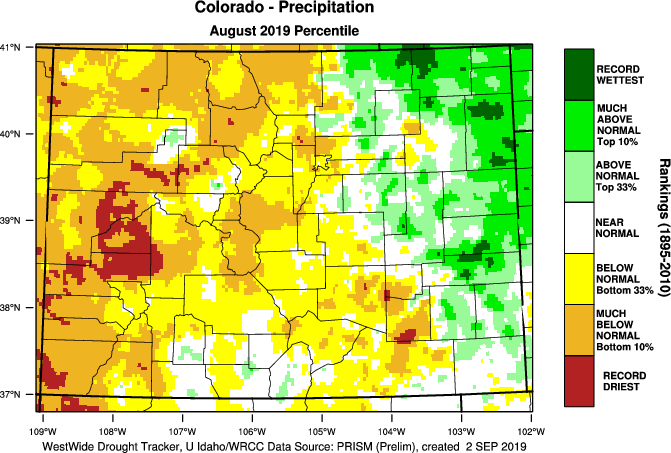
Despite heavy snowpack and mild temperatures early on, Colorado’s summer was mostly hot and dry, especially in August.
Denver, Colorado Springs, Pueblo, Alamosa and Grand Junction all had temperatures above average for July and August, according to the National Weather Service.
Scott Stearns with the Weather Service in Grand Junction said the city had 28 days during the month with temperatures at or above 90 degrees. On average, Grand Junction usually only has about 16 days with those hot temperatures.
“Rarely do we hit that average here in Western Colorado. Usually, we've got a good monsoon, a lot of moisture coming up and we're below 90 during the month of August most of the time,” Stearns said. “We keep hitting those high temperatures well through August.”
Stearns said temperatures in Grand Junction were 5.4 degrees above the normal high at 95.1 degrees. In 2018, the normal high was 92.6 degrees with 24 days at or above 90 degrees.
In Denver, the average high for August was 90.6 degrees, said Frank Cooper with the weather service in Boulder. The average monthly temperature is 73.5 degrees.
“August was the warmest month,” he said. “We were still getting some of those wet thunderstorms through like the first or second week, which is around that monsoon period. But we started to dry out fairly well toward the latter part of the month and we stayed kinda dry.”
Boulder and Denver broke record high temperatures on Sunday.
But the weather in June across Colorado was cool in comparison. Alamosa, Pueblo, Colorado Springs, Grand Junction and Denver all had below-average temperatures, according to the weather service.
Cooper said Denver didn’t reach 90 degrees until June 26, which is unusual.
“We kept our snowpack through the month and normally if it warms up really fast, we deal with a lot of runoff issues and we really didn't deal with that because it stayed cool through the first part of the summer,” he said. “We really didn't have like a really solid monsoon season. We did get periods where we got heavy rainfall from mid-July to mid-August, but generally, it was rather it was dry.”

Peter Goble, a service climatologist and drought specialist with Colorado’s Climate Center, said the combination of above-average moisture, few 90-degree days across the urban corridor in June and a great snowpack helped keep water supplies high and fire season less active.
“We managed to make it through what's typically the peak of fire season in Colorado without things getting very active,” he said. “But as long as things stay hot and dry like this, we're certainly not out of the woods yet.”
Goble predicts August will rank among the top 10 warmest and driest over the last 100 years, though official statistics won’t be released for several days.
“We may see some increased drought conditions in parts of the state,” he said. “I'm particularly concerned about southern Colorado with the monsoon not delivering as much precipitation as normal because once this time of year passes, climatologically, we tend to be drier. So as we move into later September and into October, precipitation amounts tend to start coming down across much of the state in a normal year.”
The meteorologists and climatologist predict hot and dry weather will persist for a while longer, though they all said it’s hard to forecast accurately beyond a week or two. Some moisture is expected this weekend.









